
The Mallet locomotive is a type of articulated steam railway locomotive, invented by the Swiss engineer Anatole Mallet (1837–1919).

A tender or coal-car is a special rail vehicle hauled by a steam locomotive containing its fuel and water. Steam locomotives consume large quantities of water compared to the quantity of fuel, so their tenders are necessary to keep them running over long distances. A locomotive that pulls a tender is called a tender locomotive. Locomotives that do not have tenders and carry all their fuel and water on board the locomotive itself are called tank locomotives.

The Union Pacific Big Boy is a type of simple articulated 4-8-8-4 steam locomotive manufactured by the American Locomotive Company (ALCO) between 1941 and 1944 and operated by the Union Pacific Railroad in revenue service until 1962.

A 2-8-8-4 steam locomotive, under the Whyte notation, has two leading wheels, two sets of eight driving wheels, and a four-wheel trailing truck. The type was generally named the Yellowstone, a name given it by the first owner, the Northern Pacific Railway, whose lines ran near Yellowstone National Park. Seventy-two Yellowstone-type locomotives were built for four U.S. railroads.

Under the Whyte notation for the classification of steam locomotives, 4-8-4 represents the wheel arrangement of four leading wheels on two axles, eight powered and coupled driving wheels on four axles and four trailing wheels on two axles. The type was first used by the Northern Pacific Railway, and initially named the Northern Pacific, but railfans and railroad employees have shortened the name since its introduction. It is most-commonly known as a Northern.

The Cooke Locomotive and Machine Works, located in Paterson, New Jersey, manufactured steam railroad locomotives from 1852 until it was merged with seven other manufacturers to form American Locomotive Company (ALCO) in 1901.
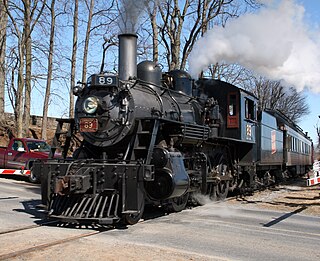
Under the Whyte notation for the classification of steam locomotives, 2-6-0 represents the wheel arrangement of two leading wheels on one axle, usually in a leading truck, six powered and coupled driving wheels on three axles and no trailing wheels. This arrangement is commonly called a Mogul.
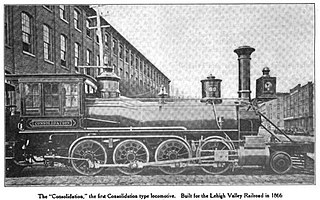
Under the Whyte notation for the classification of steam locomotives, 2-8-0 represents the wheel arrangement of two leading wheels on one axle, usually in a leading truck, eight powered and coupled driving wheels on four axles, and no trailing wheels. In the United States and elsewhere, this wheel arrangement is commonly known as a Consolidation, after the Lehigh and Mahanoy Railroad’s Consolidation, the name of the first 2-8-0.
Under the Whyte notation for the classification of steam locomotives, 0-8-0 represents the wheel arrangement of no leading wheels, eight powered and coupled driving wheels on four axles and no trailing wheels. Locomotives of this type are also referred to as eight coupled.

Under the Whyte notation for the classification of steam locomotives, a 4-8-8-2 is a locomotive with four leading wheels, two sets of eight driving wheels, and a two-wheel trailing truck.
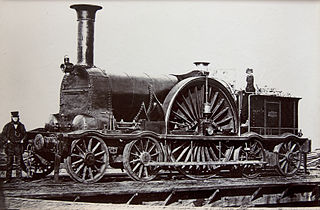
Under the Whyte notation for the classification of steam locomotives, 4-2-4 represents the wheel arrangement of four leading wheels on two axles, two powered driving wheels on one axle, and four trailing wheels on two axles. This type of locomotive is often called a Huntington type.

Under the Whyte notation for the classification of steam locomotives by wheel arrangement, 4-10-2 represents the arrangement of four leading wheels, ten powered and coupled driving wheels and two trailing wheels. In South Africa, where the wheel arrangement was first used, the type was known as a Reid Tenwheeler. In the United States of America it was known as a Southern Pacific on the Southern Pacific Railroad and as an Overland on the Union Pacific Railroad.

The San Francisco and San Jose Railroad (SF&SJ) was a railroad which linked the communities of San Francisco and San Jose, California, running the length of the San Francisco Peninsula. The company incorporated in 1860 and was one of the first railroads to employ Chinese laborers in its construction. It opened the first portion of its route in 1863, completing the entire 49.5-mile (80 km) route in 1864. The company was consolidated with the Southern Pacific Railroad in 1870. Today, Caltrain and the Union Pacific Railroad continue to operate trains over the company's original route.

El Gobernador was a 4-10-0 steam locomotive built by Central Pacific Railroad at the railroad's Sacramento, California shops. It was the last of Central Pacific's locomotives to receive an official name and was also the only locomotive of this wheel arrangement to operate on United States rails. At the time it was built, El Gobernador was the largest railroad locomotive ever built. Its name is reminiscent of the railroad's first locomotive, Gov. Stanford, as El Gobernador is Spanish for The Governor. This locomotive is a Mastodon type. Confusingly, this was the unofficial name for an earlier engine, "Mastodon" No. 229, the first successful 4-8-0 ever built. Both engines looked nearly identical, except that El Gobernador was longer and had an additional pair of drivers.

C. P. Huntington is a 4-2-4T steam locomotive on static display at the California State Railroad Museum in Sacramento, California, USA. It is the first locomotive purchased by the Southern Pacific Railroad, carrying that railroad's number 1. The locomotive is named in honor of Collis P. Huntington, the third president of the Southern Pacific Company.
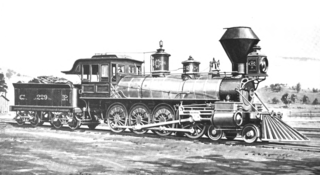
Mastodon was the unofficial name of the Central Pacific Railroad's number 229, the world's first successful 4-8-0 steam locomotive.
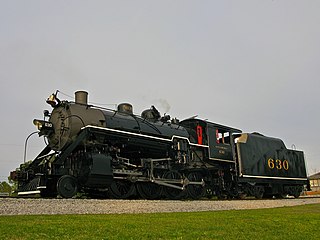
Southern Railway 630 is a 2-8-0 "Consolidation" type steam locomotive built in February 1904 by the American Locomotive Company (ALCO) of Richmond, Virginia for the Southern Railway as a member of the Ks-1 class. It is currently owned and operated by the Tennessee Valley Railroad Museum (TVRM) in Chattanooga, Tennessee where it resides today for use on excursion trains.
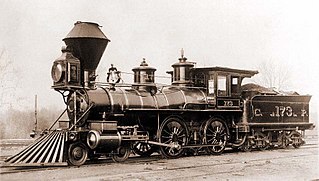
The Central Pacific Railroad number 173 was a 4-4-0 steam locomotive built by Norris-Lancaster for the Western Pacific Railroad in 1864. After its acquisition by Central Pacific, 173 was involved in a bad wreck, lying idle for two years before undergoing a sweeping reconstruction by the line's Sacramento Shops. It subsequently became the prototype for the railroad's engines when the CP began constructing locomotives. The engine was successful, and more engines were built to 173's design.
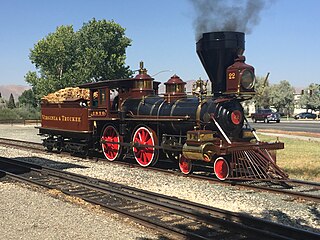
Virginia and Truckee Railroad No. 22, also known as the "Inyo", is a 4-4-0 "American" type steam locomotive that was built by the Baldwin Locomotive Works in 1875 and pulled both passenger and freight trains. The Inyo weighs 68,000 lb (31,000 kg). Its 57 in (140 cm) driving wheels deliver 11,920 lb (5,410 kg) of tractive force. In 1877 it was fitted with air brakes and in 1910 it was converted to burn oil rather than wood.
Maine Central Railroad Class O locomotives were originally intended for heavy freight service. They were of 4-6-0 wheel arrangement in the Whyte notation, or "2'C" in UIC classification. They replaced earlier class P 2-6-0 locomotives beginning in 1903. They were in turn replaced by class W 2-8-0 locomotives for the heaviest freight service beginning in 1910, but remained in use on branch line trains until replaced by diesel locomotives after World War II. They proved so well-suited for branch line service the design was among the last steam locomotives built for the Maine Central.


















